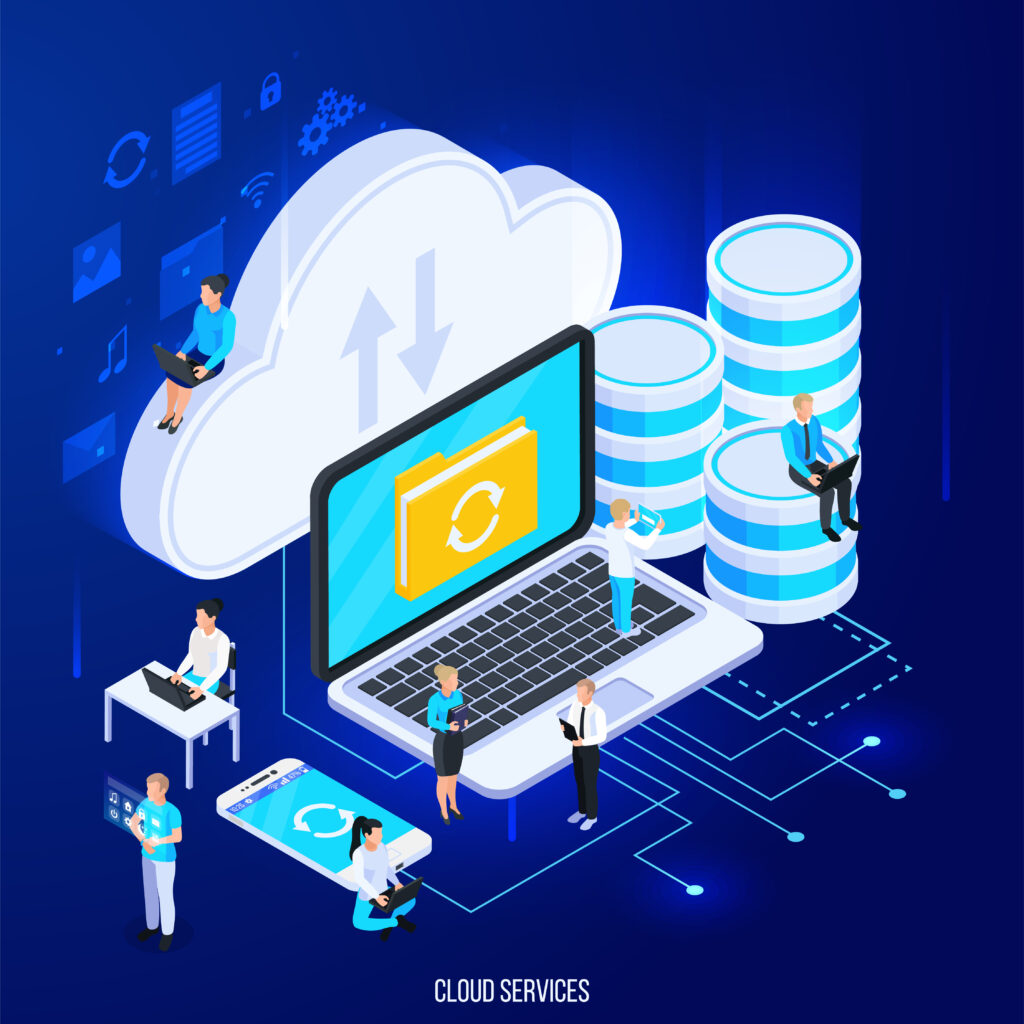There is no denying that cloud computing is becoming more and more popular. Businesses are converting to the cloud at an increasing rate for a good cause. Using the cloud can increase productivity and save money for your business. This blog post will review four advantages of cloud computing for your company.
You may cut back on hardware expenses with cloud computing. You can avoid making a costly hardware investment by using cloud computing. You only need a computer and an internet connection to get started.
You may cut software expenditures by using cloud computing. The newest software is available to you via cloud computing without you needing to buy it entirely. Additionally, purchasing software through the cloud frequently results in discounts!
The use of cloud computing can increase productivity. Employees that use cloud computing can access their work from any location with an internet connection. They can thus work from home, while traveling, or even on holiday!
Finally, energy expenses can be reduced with the use of cloud computing. Thanks to cloud computing, you no longer have to leave your office computers running nonstop. Alternatively, you can turn them off while not in use and only turn them back on as necessary. Your energy expenditures could be considerably reduced by doing this!

Saving money with cloud computing services
Public vs. private clouds
You have to choose between a public and private cloud environment when storing data and apps in the cloud. Public clouds are hosted by organizations like Amazon or Microsoft, allowing multiple businesses to share a single server. Although the data is segmented to keep it organized and secure, multitenancy enables lower costs. Additionally, public clouds are maintained by the vendor rather than by corporate workers, which reduces operational costs for the organization purchasing cloud space.
Private clouds, which typically come as a need for companies in highly regulated industries to meet compliance criteria, only store data for one specific company. The price is frequently greater than with public clouds because there is just one company per cloud environment. This also implies that upkeep falls under the purview of the organization.
Reduces the necessary amount of hardware
By leaving it to the manufacturer, public cloud computing effectively removes the expense of hardware. This is a desirable alternative for businesses that are expanding quickly because they would have to manage enormous, expensive equipment requirements. Resources may be gathered fast and efficiently with cloud computing. Additionally, all equipment replacement or repair costs will be transferred to the vendors rather than the business itself.
Other advantages of using an off-site server include space savings, hardware cost savings, and central air conditioning. An off-site server also saves money on internal power costs and floor space. Large data centers may take up priceless office space while producing heat. You might be able to save space and money by switching to cloud-based storage or applications.
Less demanding labor and maintenance
You can also reduce the cost of personnel and maintenance by using cloud solutions. There is less need for on-site IT staff because gear is owned and stored off-site by providers. Server maintenance and hardware repair are the vendor’s duty, not your business, so neither time nor money is lost.
Your IT team can devote more time to more crucial initiatives and expansions by eliminating tedious maintenance activities. In some cases, you could even be able to reduce the size of your employee’s thanks to this. The cloud will also reduce expensive third-party billing for hardware repairs for companies without an internal IT department.
Higher productivity
The use of the cloud can potentially reduce costs and increase output significantly. Cloud computing could be very cost-effective for enterprises due to speedier implementation. Cloud application installation is much quicker than conventional installation. Cloud software implementation can be completed in a matter of hours instead of weeks or months as with a company-wide installation. Employees spend more time working and less time waiting around as a result.
Additionally, adopting cloud technology speeds up adoption. SaaS programs are frequently accessed using a web browser and are quick and straightforward to understand. Last but not least, most cloud storage and software solutions are accessible from anywhere there is an internet connection. This is excellent news for companies that need to travel or have limits on telecommuting.
Lower initial capital investment
Cloud solutions are frequently offered with a pay-as-you-go pricing structure. This format offers flexibility and savings in several different ways. First and foremost, your business is not required to pay for software that isn’t being used. A cloud software license often only charges per user, as opposed to an upfront license. Pay-as-you-go software can also be canceled anytime, lowering any unreliable program’s financial risk.
The cloud is more flexible for businesses who need high-quality products but don’t have much money to invest right now, in addition to initially costing less.
Your staff can access data and applications from anywhere by storing them in the cloud. As more individuals work from home, less office space will be required. As a result, you can spend less on your rent and utilities.

Top public cloud computing providers
To help you start, here are a few fantastic cloud computing providers.
-Amazon Web Services
With a sizable market position in cloud computing, Amazon Web Services (AWS) offers various features, such as analytics, storage, developer tools, and security. The system offers a pay-as-you-go arrangement that enables companies to pay for the services they use each month instead of paying for a year’s worth of service upfront. Because it operates several data centers throughout the globe, AWS is highly known.
-Google Cloud
However, Google Cloud may offer great value for individuals new to cloud computing. Google Cloud is continuing to expand its cloud portfolio. The platform is accessible in over 200 countries and supports many businesses, including software development and healthcare. Google gives even new users free credits to help them get started. Customers value the service’s versatility and the wide range of available options.
-Microsoft Azure
Microsoft Azure is picking up speed in the drive to overtake AWS for the lion’s share of the cloud computing market. They have more than 200 products available, including help for IoT, AI, ML, and mobile app development, and they’re bringing in new clients by offering free subscriptions to some of their most well-liked services for a full year. Customers who have chosen Microsoft Azure do so for its dependability and simplicity of usage.

What is a public cloud?
A cloud service provider’s software makes resources remotely accessible to consumers through the widely used cloud computing model, such as virtual computers, applications, or storage. Depending on the subscription or on-demand pricing model chosen, public cloud services may be free or charged for, including pay-per-use.
The main benefits of the public cloud are as follows:
- Organizations no longer have to spend money on and maintain their on-premises IT resources, among other advantages.
- The platform’s scalability may be increased to accommodate workload and user demands, just like with current blockchain technology.
- Customers just pay for the services they utilize, resulting in less resource waste.
How does the public cloud work?
Public cloud computing is an alternate application development method to on-premises IT architectures. In the fundamental public cloud computing paradigm, a third-party provider hosts scalable, on-demand IT resources and distributes them to consumers over a network connection, either over the open internet or a specialized network.
The public cloud model includes various unique technologies, skills, and features. However, a public cloud is based on the following fundamental traits:
- On-demand computing: the capacity to access data and applications as required without requiring installation or configuration locally;
- Self-service provisioning: allowing people to create their accounts and instantly access resources.
- Investment accounts under Accounts and Investments
- The ability of many blockchain systems to scale and adapt quickly has grown in popularity, while it is still unclear whether this means that a block-chain based economy might accomplish such things.
- Each of the several types of license arrangements is catered to a certain industry or group of users. The most popular type of pricing, per-use, enables companies to bill on usage rather than time;
- surveillance and recording of a service
- It’s crucial to have a secondary energy supply. While there is an outage or brownout in your neighborhood, a generator will offer power even when the sun is shining. When you don’t want to rely on public utilities for everything from telephone and internet connections to television and radio programming, a well-designed generator can be a backup supply. availability and resilience
- protection; evidence of insurance.
- Everyone has access to the internet.
The public cloud provider offers customer management capabilities and the technology required for hosting and deploying workloads. These consist of monitoring, security, and data storage services.

How Much Does Cloud Computing Cost?
The price is the primary consideration for customers of cloud services before making a purchase. Well, that depends on the kind of business you run and what your needs are. You can choose any service based on how many levels of effective operations you require, but bear in mind that the most expensive does not necessarily guarantee the highest quality.
Strategize before taking action so you won’t regret it down the line by factoring in these key points:
- What kind of “cloud” you’ll have to buy (public, private, or hybrid)
- For instance, will you save all the IT infrastructure or personal data?
- We either ran out of office space or needed disaster recovery, so we switched to cloud services.
A cloud service’s price fluctuates depending on several variables, such as significant requirements and detailed specifications. A business customer will have to pay more for a cloud service than a consumer.
Using the Calculators
How can you easily calculate your cloud computing costs? There are numerous methods, including the use of spreadsheets and bookkeeping software. However, using the “calculators” offered by “cloud service providers” is the most reliable, effective, and safe option. Several well-known companies have created calculators to determine your total ownership cost. This is the quickest way to comprehend how much cloud computing services cost.
Here are the most popular and ideally rated options:
- AWS TCO Calculator (Amazon Web Services)
- Uncertain about the price of Google Cloud Platform? To get a ballpark figure, use our pricing estimator.
- Azure Pricing Calculator for Microsoft Azure:
- Bluemix on the IBM Cloud Pricing Sheet
- We at Interoute recognize that every company is unique. Because of this, we provide a range of price choices to meet your unique requirements.
- A cloud-based calculator called Rackspace offers immediate results for many different procedures.
- Red Hat: Use our Red Hat Infrastructure ROI TCO Calculator to calculate your potential savings.
- CenturyLink Cloud: Use our Price Estimator tool to get an idea of your CenturyLink Cloud prices.
- You can quickly determine the cost of VMware vCloud Air using the robust tool VMware vCloud.
- ProfitBricks is the solution to use if you want to reduce the cost of your data center. Using our Virtual Data Center Calculator, you can quickly assess how much you can save by switching to ProfitBricks.

Why Cloud computing scalability matters for business growth
The use of the cloud can significantly accelerate business growth. Cloud computing allows companies to extend their operations rapidly and effectively, enabling them to enter new markets and take advantage of new opportunities.
Scalability is one of the main advantages of cloud computing. This implies that enterprises can modify their use of cloud-based services following their requirements without paying additional fees. This adaptability is crucial for companies expanding quickly or competing in industries where success depends on quickness.
Cloud-based services are typically more affordable than conventional on-premises solutions in addition to being scalable. This is so that companies don’t have to invest in costly infrastructure that might only be used rarely. Instead, they only pay for the resources they use.
Additionally, cloud computing can aid companies in increasing productivity. By relieving IT workers of overseeing on-premises infrastructure, they can concentrate on more strategic duties that will advance the company. Additionally, employees’ ability to work flexibly and communicate more effectively thanks to cloud-based services’ accessibility from anywhere may help to boost productivity.

What is scalability in cloud computing, and how it affects business scalability?
Scalability in a business setting is the ability to grow and withstand the stress of rising output without being constrained by structure or resources. A scalable system can manage a more significant workload while maintaining or increasing its effectiveness.
In other words, scalability in the context of cloud computing refers to the capacity to increase or decrease infrastructure resources in response to changes in client demand.
One aspect that makes cloud computing appealing and well-liked by organizations is scalability, one of its key benefits. Business scalability is impacted by the cloud’s intrinsic ability to scale up or down. Because it makes it possible for you to increase your current resources to meet your expanding demands. You might thus grow without having to invest in expensive infrastructure changes. Put another way; if your business is not scalable, you will experience financial losses if customers demand your services but cannot meet their needs. Things can become much more challenging if you have invested in infrastructure that is not being used. The scalability of cloud computing implies that your platform’s users will exhaust its resources.
Conclusion
Because it provides several advantages, such as cost savings and better productivity, cloud computing is becoming an option that businesses choose more frequently. This blog post has covered four ways cloud computing can help your business save money. Please contact us immediately if you’re interested in learning more about how the cloud may help your company. We would be delighted to go over your options with you and assist you in making a move to the cloud.























